Denmark 2009 "Danish Nature"
| <prev | back to index | next> |
| Issue Date | 25.03.2009 |
| ID | Michel: 1524-1527, Bl. 36, 1525KB; Scott: 1430-1433, 1433a, 1431a; Stanley Gibbons: 1548-1551, MS1552, ?; Yvert et Tellier: 1527-1530, BF37, ?; Category: pF |
| Design |
Photos: Jimmy Lassen, Jens Schou (DKK 5.00) John Larsen (DKK 5.50) Steen Drozd Lund, Tommy Kaae (DKK 8.00) Nils Natorp / GeoCenter Moens klint (DKK 17.00) Design: Martin Moerck |
| Stamps in set | 4 |
| Values |
DK5.00 - Pyramidal Orchids DK5.50 - Peregrine Falcon DK8.00 - Thyme zygaenidae DK17.00 - Mosasaur teeth |
| Size (width x height) | stamps: 24mm x 31mm, Mini-Sheet: 150mm x 70mm |
| Layout | Sheets of 50 stamps (10x5), Mini-Sheet of 4, Mini-Sheet of 8 stamps of falcon, Booklet with 10 stamps of falcon |
| Products | FDC x2, Mini-Sheets x2, Presentation Pack x1, Booklet x1 |
| Paper | |
| Perforation | 12.75 x 12.75 |
| Print Technique | 4-colour offset, lithography |
| Printed by | Post Danmark Stamps |
| Quantity | |
| Issuing Authority | Post Denmark |

On March 25th, 2023, the Post Authority of Denmark issued the set of 4 stamps "Danish Nature".
These stamps were printed in separate sheets of 50 and a Souvenir-Sheet of all 4. The falcon stamp was also issued in Mini-Sheet of 8 stamps plus a tab in the middle and in a booklet of 10.
Over a number of years, Post Danmark's "Danish Nature" series has been celebrating the diversity of Denmark's native flora and fauna, and has featured familiar species as well as more rare specimens. This year, four stamps were issued based on the unique nature in and around Moens Klint (originally spelled Møns Klint). Thanks to its varied landscape and chalky soil, many of the animals and plants found here are unknown elsewhere in Denmark.
Moens Klint is a 6 km stretch of limestone and chalk cliffs along the eastern coast of the Danish island of Møn in the Baltic Sea. Some of the cliffs fall a sheer 120 m to the sea below. The highest cliff is Dronningestolen, which is 128 m above sea level. The area around Moens Klint consists of woodlands, pastures, ponds and steep hills, including Aborrebjerg which, with a height of 143 m, is one of the highest points in Denmark. The cliffs and adjacent park are now protected as a nature reserve.

The chalk of Moens Klint on postcard of Denmark 1998
The chalk of Moens Klint contains fossils of marine species that lived in the area some 70 million years ago.
Three teeth found on the beach at Moens Klint in 2007 turned out to be from a mosasaur. One of the teeth was featured on one of the stamps from this set (see below).
 |
 |
| Mosasaur teeth on stamp of Denmark 2009, MiNr.: 1527, Scott: 1433. | The first postage stamp with reconstruction of Mosasaur, Poland 1965, MiNr.: 1573, Scott: 1310. |
Mosasaur, (family Mosasauridae), are an extinct group of aquatic lizards that attained
a high degree of adaptation to the marine environment and were distributed
worldwide during the Cretaceous Period (145.5 million to 66 million years ago).
Their first fossil remains were discovered in a limestone quarry at Maastricht
in the Netherlands, on the Meuse in 1764.
Mosasaurs breathed air, were powerful swimmers, and were well-adapted to living
in the warm, shallow inland seas prevalent during the Late Cretaceous period.
During the last 20 million years of the Cretaceous period (Turonian–Maastrichtian
ages), with the extinction of the
ichthyosaurs and
pliosaurs, mosasaurs became the dominant marine predators.
The longest mosasaurs, based on a specimen of Mosasaurus hoffmanni, are
estimated to have been 17 metres in length, but the most common forms were
between 2 metres and 7 metres long, the smallest species were 30 cm only.
The biggest species of Mosasaur were the most feared marine predator of
the Cretaceous Period who hunted and devoured sharks, octopuses, and even smaller
members of its own species.
Mosasaurs had a snakelike body with a large skull and a long snout.
The structure of the skull was very similar to that of the modern monitor lizards,
to which mosasaurs are related.
The jaws bore many conical, slightly recurved teeth set in individual sockets.
Mosasaurs did not use permanent teeth but instead constantly shed them.
Replacement teeth developed within a pit inside the roots of the original tooth
called the resorption pit.
Mosasaurs had double-hinged jaws and flexible skulls (much like those of snakes),
which enabled them to gulp down their prey almost whole.
Some researchers suggest, mosasaurs probably had a sensitive forked, snakes-like, tongue.
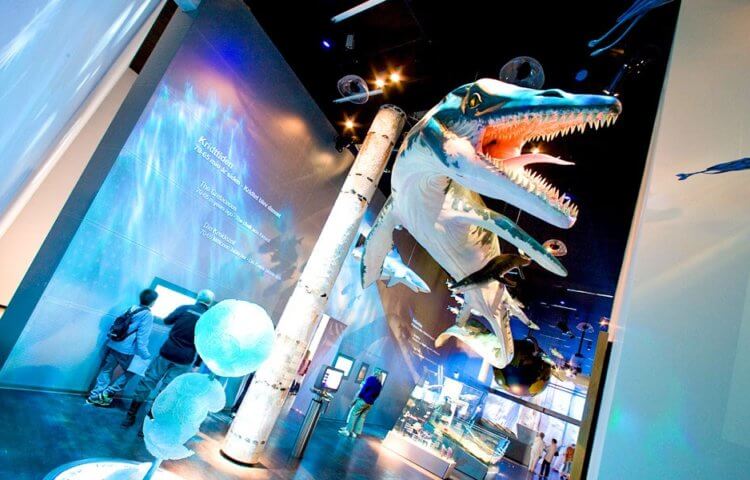 |
| Reconstruction of the Mosasaur in the GeoCenter Moens Klint. Image credit: Moenguide.com |
There are several exhibitions dedicated to the natural history of the region.
The exhibition has been structured around a time travel of 70 million years' duration.
Here high-technological exhibition techniques, free artistic interpretations and rare fossils will take you from the bottom of the Chalk Ocean and directly up to the unique nature to be found on the present-day Cliff of Moen.
The exhibition comprises a prehistoric element, a present-day element, a workshop, a climbing cave, a small cinema below the glacier and a 3-D cinema.
The workshop is an active workplace where, throughout the day, children and adults can partake in lots of exciting activities together with the nature guide.
| The photos below are from the Presentation Pack | |||
 |
|||

|

|  |
 |
| Pyramidal Orchids | Peregrine Falcon | Thyme zygaenidae | Mosasaur reconstruction on stamp of Belgium 2018 |
 |
GeoCenter Moens Klint is owned by a private commercial foundation established in accordance with non-profit principles for the purpose of running a geology and nature centre at the Cliff of Moen, including being of service to the audience and to provide presentation of nature and culture matters; providing other nature and cultural presentation for the common good.
Her Royal Highness Queen Margrethe is the protector of GeoCenter Moens Klint.
The Queen was depicted on many stamps of Denmark, including "Queen Margrethe II-Jubilee" from 1997. One of the four stamps of the set is shown on the right (MiNr.: 1144, Scott: 1065.).
Products and associated philatelic items
| FDC | ||
| FDC with single stamps | FDC with the Mini-Sheet | Personalized FDC |
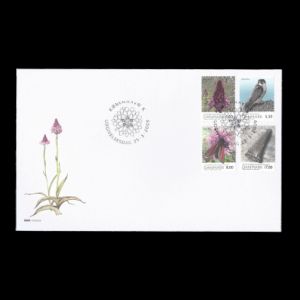 |
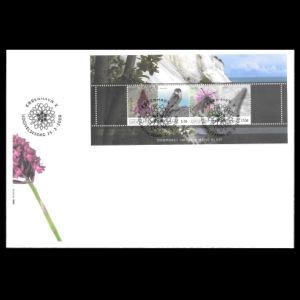 |
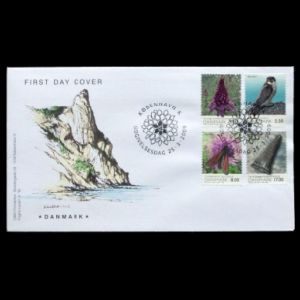 |
| Presentation Pack | Mini-Sheet with all stamps of the set | Booklet with the Falcon stamps |
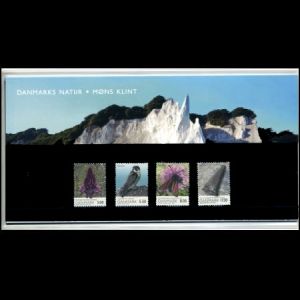 |
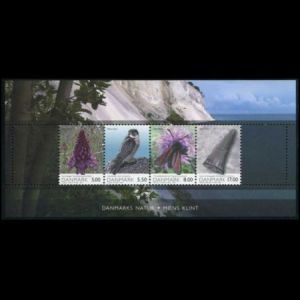 |
 |
| Inside text is here | The booklet contain a strip of 10 stamps (5x2). Example of used strip is here | |
| Mini-Sheet with the Falcon stamps | ||
|
|
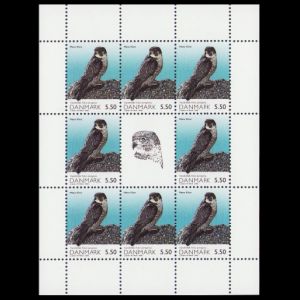 |
|

|
- Technical details and short description of the stamps:
Presentation Pack, - Moens Klint:
Wikipedia,- GeoCenter Moens Klint:
official website,
- GeoCenter Moens Klint:
- Mosasaur:
Wikipedia, Encyclopedia Britannica,
"Ancient Sea Reptiles: Plesiosaurs, Ichthyosaurs, Mosasaurs, and More", by Darren Naish, published in 2023, ISBN: 1588347273.
Acknowledgements:
Many thanks to Dr. Peter Voice, PhD Department of Geological and Environmental Sciences, Western Michigan University, USA, for review of a draft of this article and his very valuable comments.
| <prev | back to index | next> |